Blue-eyed, round-faced Alma Taylor (1895-1974) was a British actress, who peeked in the British silent cinema of the 1910s and 1920s. In 1915 readers of Pictures and Picturegoers voted her most popular British performer, beating even Charlie Chaplin. Taylor acted in over 150 films, among which some prestigious examples like Shadow of Egypt (Sidney Morgan, 1924), filmed on location in Egypt.
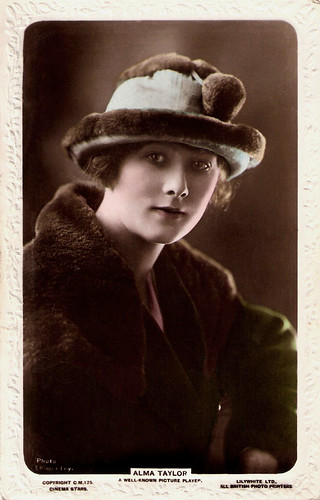
British postcard in the Lilywhite Photographic Series.

British postcard by Beagles in the Famous Cinema Star Series, no. 150 C. Photo: Elliott & Fry.
Alma Taylor was born in London, Great Britain, in 1895. According to Anthony Slide, brunette, blue-eyed she was the Hepworth actress 'par excellence'. Beginning as a child in 1907, Alma Taylor already acted with producer Cecil Hepworth, playing tragic young girls in his short silent films.
The photogenic brunette then co-starred with Chrissie White in Hepworth's 'Tilly the Tomboy' comedy series (1910-1915) about two naughty schoolgirls.
Hans J. Wollstein at AllMovie: "The other Tilly girl was Chrissie White and each in her own way would come to personify the typical British silent screen heroine: innocuous, well-mannered, and invariably dressed for comfort."
Taylor would appear in 75 or more short and long subjects by Hepworth, such as the Charles Dickens adaptations Oliver Twist (Thomas Bentley, 1912) as Nancy, David Copperfield (Thomas Bentley, 1913) and The Old Curiosity Shop (Thomas Bentley, 1913).
In those days, everyone helped out at the studios, so both Alma and Chrissie helped in the processing rooms when the weather was too poor to shoot.
During the First World War and soon after Taylor contributed to the war effort by acting in such propaganda films like The Nature of the Beast (Cecil Hepworth, 1919).
Taylor clearly was the producer's favourite, and remained devoted to him for decades. In 1923, she starred opposite Ralph Forbes in the rather old-fashioned British countryside drama Comin' Thro the Rye (Cecil Hepworth, 1923), a remake of an earlier version by Hepworth.
Taylor played her usual heroine, suffering nobly and at great length after losing her man to another woman.
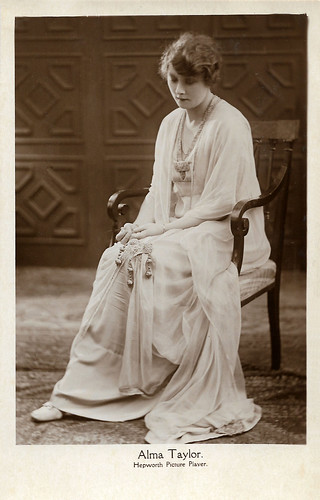
British postcard. Photo: Hepworth.

British postcard. Photo: Hepworth.

British postcard. Photo: Hepworth.
After a temporal absence from the screen, Cecil Hepworth re-launched Alma Taylor in his last film, The House of Marney (Cecil Hepworth, 1926), with John Longden.
In 1924, the Daily News named Alma Taylor, along with Betty Balfour, 'Britain's top star'. Taylor only starred in four non-Hepworth films: The Shadow of Egypt (Sidney Morgan, 1924) with Joan Morgan, Quinneys (Maurice Elvey, 1927), A South Sea Bubble (T. Hays Hunter, 1928) with Ivor Novello, and Two Little Drummer Boys (G.B.Samuelson, 1928).
In the late silent era, she did some German films, including her part of Mrs. Barrymore in Der Hund von Baskerville/The Hound of the Baskervilles (Richard Oswald, 1929). This film was considered lost for a long time, but it was rediscovered in 2009.
With the coming of sound, however, Taylor's career dwindled and she had to be satisfied with minor, matronly roles, in s small number of films. These included Bachelor's Baby (Harry Hughes, 1932), Things Are Looking Up (Albert de Courville, 1935), Lilacs in the Spring (Herbert Wilcox, 1954), and Blue Murder at St. Trinian's (Frank Launder, 1957).
Uncredited, she played a box office woman in Hitchcock's second version of The Man Who Knew Too Much (Alfred Hitchcock, 1956).
Probably her last part was the uncredited role of an old lady in the Titanic-drama by Rank, A Night to Remember (Roy Ward Baker, 1958).
Alma Taylor died in London, in 1974. She was the wife of film producer and director Walter West (1885-1958). In the late 1910s and early 1920s, West was the regular director of Violet Hopson, first with his company Broadwest (1914-1921) and then for Hopson's own company.
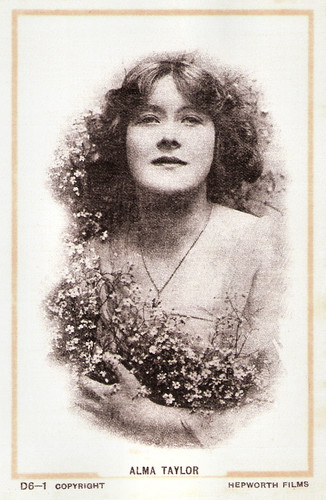
British postcard by Hepworth Films, no. D6-1.
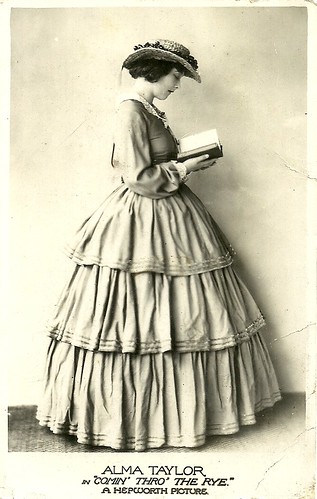
British postcard by TIC. Photo: Hepworth. Publicity still for Comin' Thro the Rye (Cecil Hepworth, 1923).
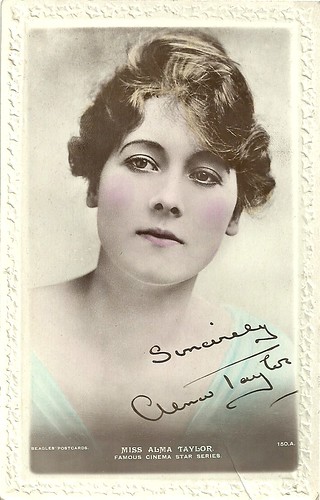
British postcard by Beagles in the Famous Cinema Star Series, no. 150A.
Sources: Anthony Slide (Encyclopedia of British Film), Hans J. Wollstein (AllMovie), Hepworthfilm, Wikipedia and IMDb.

British postcard in the Lilywhite Photographic Series.

British postcard by Beagles in the Famous Cinema Star Series, no. 150 C. Photo: Elliott & Fry.
Hepworth' favourite
Alma Taylor was born in London, Great Britain, in 1895. According to Anthony Slide, brunette, blue-eyed she was the Hepworth actress 'par excellence'. Beginning as a child in 1907, Alma Taylor already acted with producer Cecil Hepworth, playing tragic young girls in his short silent films.
The photogenic brunette then co-starred with Chrissie White in Hepworth's 'Tilly the Tomboy' comedy series (1910-1915) about two naughty schoolgirls.
Hans J. Wollstein at AllMovie: "The other Tilly girl was Chrissie White and each in her own way would come to personify the typical British silent screen heroine: innocuous, well-mannered, and invariably dressed for comfort."
Taylor would appear in 75 or more short and long subjects by Hepworth, such as the Charles Dickens adaptations Oliver Twist (Thomas Bentley, 1912) as Nancy, David Copperfield (Thomas Bentley, 1913) and The Old Curiosity Shop (Thomas Bentley, 1913).
In those days, everyone helped out at the studios, so both Alma and Chrissie helped in the processing rooms when the weather was too poor to shoot.
During the First World War and soon after Taylor contributed to the war effort by acting in such propaganda films like The Nature of the Beast (Cecil Hepworth, 1919).
Taylor clearly was the producer's favourite, and remained devoted to him for decades. In 1923, she starred opposite Ralph Forbes in the rather old-fashioned British countryside drama Comin' Thro the Rye (Cecil Hepworth, 1923), a remake of an earlier version by Hepworth.
Taylor played her usual heroine, suffering nobly and at great length after losing her man to another woman.

British postcard. Photo: Hepworth.

British postcard. Photo: Hepworth.

British postcard. Photo: Hepworth.
Britain's top star
After a temporal absence from the screen, Cecil Hepworth re-launched Alma Taylor in his last film, The House of Marney (Cecil Hepworth, 1926), with John Longden.
In 1924, the Daily News named Alma Taylor, along with Betty Balfour, 'Britain's top star'. Taylor only starred in four non-Hepworth films: The Shadow of Egypt (Sidney Morgan, 1924) with Joan Morgan, Quinneys (Maurice Elvey, 1927), A South Sea Bubble (T. Hays Hunter, 1928) with Ivor Novello, and Two Little Drummer Boys (G.B.Samuelson, 1928).
In the late silent era, she did some German films, including her part of Mrs. Barrymore in Der Hund von Baskerville/The Hound of the Baskervilles (Richard Oswald, 1929). This film was considered lost for a long time, but it was rediscovered in 2009.
With the coming of sound, however, Taylor's career dwindled and she had to be satisfied with minor, matronly roles, in s small number of films. These included Bachelor's Baby (Harry Hughes, 1932), Things Are Looking Up (Albert de Courville, 1935), Lilacs in the Spring (Herbert Wilcox, 1954), and Blue Murder at St. Trinian's (Frank Launder, 1957).
Uncredited, she played a box office woman in Hitchcock's second version of The Man Who Knew Too Much (Alfred Hitchcock, 1956).
Probably her last part was the uncredited role of an old lady in the Titanic-drama by Rank, A Night to Remember (Roy Ward Baker, 1958).
Alma Taylor died in London, in 1974. She was the wife of film producer and director Walter West (1885-1958). In the late 1910s and early 1920s, West was the regular director of Violet Hopson, first with his company Broadwest (1914-1921) and then for Hopson's own company.

British postcard by Hepworth Films, no. D6-1.

British postcard by TIC. Photo: Hepworth. Publicity still for Comin' Thro the Rye (Cecil Hepworth, 1923).

British postcard by Beagles in the Famous Cinema Star Series, no. 150A.
Sources: Anthony Slide (Encyclopedia of British Film), Hans J. Wollstein (AllMovie), Hepworthfilm, Wikipedia and IMDb.
No comments:
Post a Comment